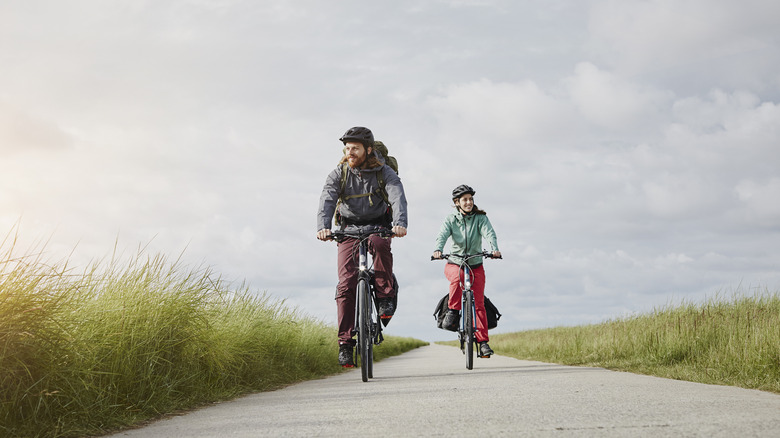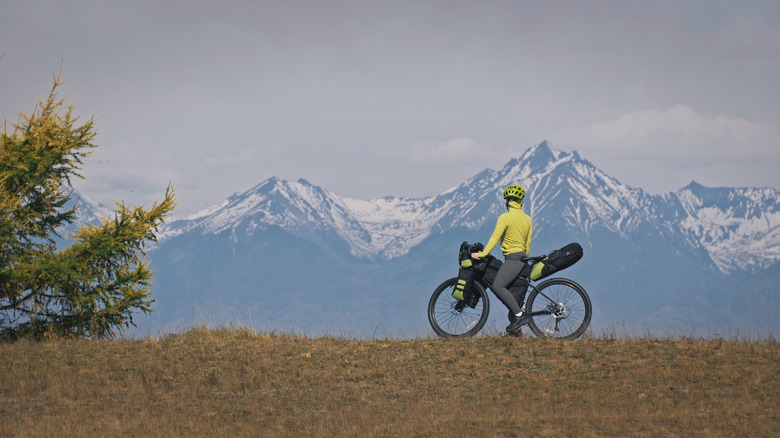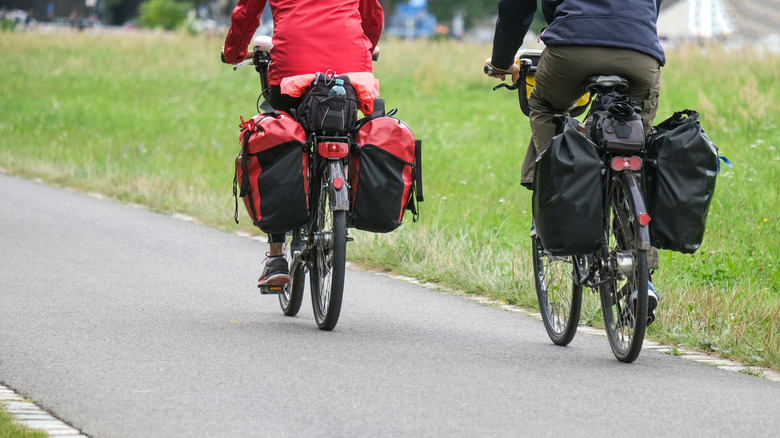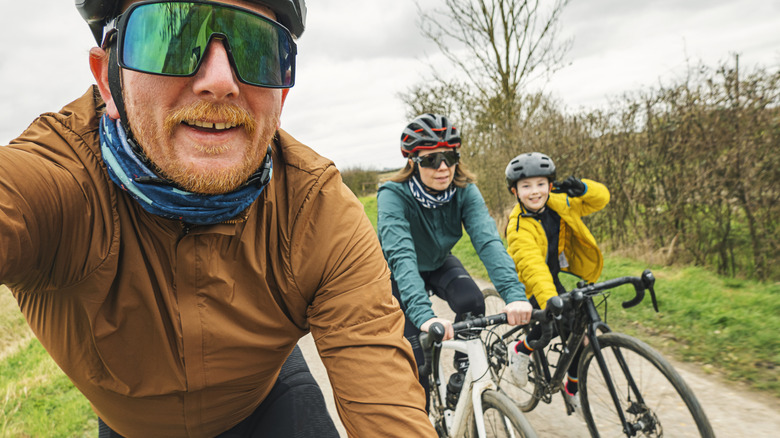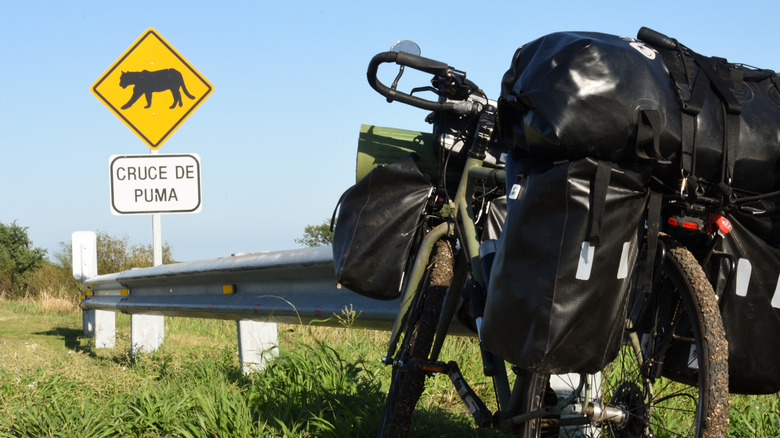Bikepacking Vs Bike Touring: Which Kind Of Two-Wheeled Tourist Are You?
There's something special about the joy of exploring the world on a bicycle. The wind in your face, the freedom to explore the world's longest and most scenic bike trails, and the satisfying exhaustion at the end of the day all make for a pretty unforgettable experience. That said, not all cycling trips are created equal. And there's a big distinction (and ongoing discussion) between the two approaches that have become increasingly popular and accessible over the past few years.
Often used interchangeably, the terms "bikepacking" and "bike touring" actually refer to two very different approaches to cycling and travel. However, it's not just about terminology — it's also about functionality. The real differences ultimately boil down to where you ride and how you carry your stuff. So, while bike touring typically sticks to paved roads and packed gravel with gear loaded into panniers hanging from racks, bikepacking tackles more rugged terrain with bags strapped directly to your frame.
Nonetheless, despite these stark differences, the truth is that both of these two-wheeled approaches are an incredible way to see and explore more of the world. Whether you prefer more comfortable rides between small towns or challenging journeys through remote wilderness, there's nothing a bike adventure can't deliver. And who knows? Your travels might even take you to some of the most beautiful places you've only seen virtually via your Peloton workout.
What a bikepacking adventure entails
Bikepacking is basically a combination of mountain biking with backpacking principles to create an off-road adventure experience. Primarily focused on traveling light and staying nimble enough for rough terrains, bikepacking prioritizes mobility over capacity. That's why, instead of using traditional racks and panniers, bikepackers attach specialized bags directly to their frame, handlebars, and seat post — ultimately cutting down on any excess bulk and width.
As such, bikepacking setups keep gear narrow and balanced, which allows riders to navigate single-track trails, forest service roads, and remote paths that would otherwise be harder to cross with wider, loaded touring bikes. Instead, your gear stays compact and strategically placed, with frame bags that fit directly inside the front triangle, seat bags that extend behind the saddle, and handlebar rolls used for carrying lightweight items like sleeping gear.
Lastly, bikepacking bikes also typically feature more advanced components designed specifically for off-road performance. In most cases, these bikes tend to have slightly higher gear ratios than touring bikes, and often include features like suspension to handle rough terrain. Plus, since they're meant for carrying lighter loads, the frames are also usually less rigid than most touring models — which results in a more responsive ride when unloaded. Nonetheless, these bikes still maintain their trail-worthiness even when loaded with gear, so you don't need to worry about stability or losing control halfway through your ride.
What does it mean to go bike touring?
On the other hand, bike touring is considered a more traditional approach to multi-day cycling trips that focus on comfortable travel through mostly paved roads and well-maintained gravel paths. In most cases, this style prioritizes carrying capacity and stability over technical trail ability. That said, the defining feature of a bike touring adventure is the use of panniers: rectangular bags that attach to racks mounted above your wheels.
With bike touring, the goal is to position weight as low as possible on your bike. This lowers your center of gravity significantly, which helps create better stability even at high speeds. Additionally, unlike bikepacking setups, panniers also offer a much greater carrying capacity, making it easier to pack everything from camping gear to food, cooking equipment, and extra clothing. All of which ultimately contributes to a more comfortable experience than ultralight bikepacking allows for.
Lastly, in terms of design, touring bikes feature more robust frames built to handle heavier loads without compromising stability. They also typically come with lower gear ratios to help climb hills while carrying extra weight. Additionally, touring bikes include numerous mounting points for racks, fenders, and accessories. And, while they might feel less lively when unloaded compared to bikepacking rigs, touring bikes are excellent at fulfilling their intended purpose: carrying substantial loads comfortably over long distances on relatively smooth surfaces.
Choosing the right fit for your adventure
At the end of the day, your ideal cycling adventure style depends primarily on where you want to go and what experience you're looking for. If you're drawn to remote backcountry trails and technical terrain, bikepacking offers the thrill of reaching pristine campsites along the road (or trail) less traveled. So, if pedaling deep into the wilderness, setting up camp beside alpine lakes, and waking up to mountain views that can't be accessed by car sounds like the ideal getaway, bikepacking might be for you.
Meanwhile, for journeys that cruise through changing landscapes and diverse communities, traditional bike touring offers better opportunities for a touch more of cultural immersion. This includes the excitement of rolling in and out of small towns, striking up conversations with locals at diners, and riding along some of the most beautiful bike trails across the U.S. — all of which adds up to a different kind of adventure. One where the human aspect of the journey often becomes just as memorable as the landscapes you're crossing.
Enjoying the best of both worlds
If you're still undecided, the good news is that you don't necessarily have to choose between bikepacking and bike touring. Nowadays, plenty of cyclists enjoy a perfect middle ground that combines elements from both worlds, which opens up the door to even more adventures. A great way to do this is to test the waters by embarking on a pre-planned getaway or cycling along forest roads closer to home on a "Sub-24-Hour Overnight" (S24O) trip. Better yet, this multi-style approach also means you don't necessarily have to worry too much about any of the technicalities and details that more experienced riders tend to obsess over.
After all, your first multi-day cycling trip should be more about the experience itself — the satisfaction of traveling under your own power, the earned exhaustion at the end of the day, and the simple pleasure of falling asleep under the stars — than about the gear, equipment, and accessories you're carrying. So don't be afraid to start small, embrace the challenges, and try different setups. You'll soon find out which style calls to your adventurous spirit the most.
